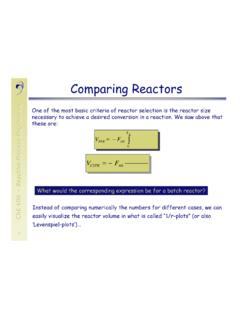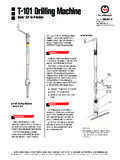Transcription of Low-Power Sub-1 GHz RF Transceiver
1 cc1101 . Low-Power Sub-1 GHz RF Transceiver Applications Ultra Low-Power wireless applications Wireless sensor networks operating in the 315/433/868/915 MHz AMR Automatic Meter Reading ISM/SRD bands Home and building automation Wireless alarm and security systems Wireless MBUS. Industrial monitoring and control Product Description cc1101 is a low-cost Sub-1 GHz Transceiver microcontroller and a few additional passive designed for very Low-Power wireless appli- components. cations. The circuit is mainly intended for the The CC1190 850-950 MHz range extender [21]. ISM (Industrial, Scientific and Medical) and SRD (Short Range Device) frequency bands can be used with cc1101 in long range at 315, 433, 868, and 915 MHz, but can easily applications for improved sensitivity and higher be programmed for operation at other output power.
2 Frequencies in the 300-348 MHz, 387-464 MHz and 779-928 MHz bands. The RF Transceiver is integrated with a highly configurable baseband modem. The modem 20. 19. 18. 17. 16. supports various modulation formats and has 1 15. a configurable data rate up to 600 kbps. cc1101 . 2 14. 3 13. cc1101 provides extensive hardware support 4 12. for packet handling, data buffering, burst 5 11. transmissions, clear channel assessment, link 10. 6. 7. 8. 9. quality indication, and wake-on-radio. The main operating parameters and the 64- byte transmit/receive FIFOs of cc1101 can be controlled via an SPI interface. In a typical system, the cc1101 will be used together with a SWRS061I Page 1 of 98. cc1101 . Key Features RF Performance Low-Power Features 200 nA sleep mode current consumption High sensitivity Fast startup time; 240 s from sleep to RX.
3 O -116 dBm at kBaud, 433 MHz, or TX mode (measured on EM reference 1% packet error rate design [1] and [2]). o -112 dBm at kBaud, 868 MHz, 1% packet error rate Wake-on-radio functionality for automatic Low-Power RX polling Low current consumption ( mA in RX, kBaud, 868 MHz) Separate 64-byte RX and TX data FIFOs (enables burst mode data transmission). Programmable output power up to +12. dBm for all supported frequencies Excellent receiver selectivity and blocking General performance Few external components; Completely on- Programmable data rate from to 600 chip frequency synthesizer, no external kbps filters or RF switch needed Frequency bands: 300-348 MHz, 387-464 Green package: RoHS compliant and no MHz and 779-928 MHz antimony or bromine Small size (QLP 4x4 mm package, 20. Analog Features pins).
4 Suited for systems targeting compliance 2-FSK, 4-FSK, GFSK, and MSK supported with EN 300 220 (Europe) and FCC CFR. as well as OOK and flexible ASK shaping Part 15 (US). Suitable for frequency hopping systems Suited for systems targeting compliance due to a fast settling frequency with the Wireless MBUS standard synthesizer; 75 s settling time EN 13757-4:2005. Automatic Frequency Compensation Support for asynchronous and (AFC) can be used to align the frequency synchronous serial receive/transmit mode synthesizer to the received signal centre for backwards compatibility with existing frequency radio communication protocols Integrated analog temperature sensor Improved Range using CC1190. Digital Features The CC1190 [21] is a range extender for Flexible support for packet oriented 850-950 MHz and is an ideal fit for cc1101 .
5 Systems; On-chip support for sync word to enhance RF performance detection, address check, flexible packet length, and automatic CRC handling High sensitivity o -118 dBm at kBaud, 868 MHz, Efficient SPI interface; All registers can be 1% packet error rate programmed with one burst transfer o -120 dBm at kBaud, 915 MHz, Digital RSSI output 1% packet error rate Programmable channel filter bandwidth +20 dBm output power at 868 MHz Programmable Carrier Sense (CS). +27 dBm output power at 915 MHz indicator Refer to AN094 [22] and AN096 [23] for Programmable Preamble Quality Indicator more performance figures of the cc1101 +. (PQI) for improved protection against false sync word detection in random noise CC1190 combination Support for automatic Clear Channel Assessment (CCA) before transmitting (for listen-before-talk systems).
6 Support for per-package Link Quality Indication (LQI). Optional automatic whitening and de- whitening of data SWRS061I Page 2 of 98. cc1101 . Reduced Battery Current using battery is typically 22 mA when TPS62730. TPS62730 output voltage is V. When connecting cc1101 directly to a V battery the The TPS62730 [26] is a step down current drawn is typically 34 mA (see converter with bypass mode for ultra low Figure 2). power wireless applications. When cc1101 enters SLEEP mode, the In RX, the current drawn from a V TPS62730 can be put in bypass mode for battery is typically less than 11 mA when very low power down current TPS62730 output voltage is V. When The typical TPS62730 current consumption connecting cc1101 directly to a V is 30 nA in bypass mode. battery the current drawn is typically 17 The cc1101 is connected to the battery via mA (see Figure 1) an integrated (typical) switch in In TX, at maximum output power (+12 bypass mode dBm), the current drawn from a V.
7 Figure 1: Typical RX Battery Current vs Battery Voltage Figure 2: Typical TX Battery Current vs Battery Voltage at Maximum cc1101 Output Power (+12. dBm). SWRS061I Page 3 of 98. cc1101 . Abbreviations Abbreviations used in this data sheet are described below. 2-FSK Binary Frequency Shift Keying MSB Most Significant Bit 4-FSK Quaternary Frequency Shift Keying MSK Minimum Shift Keying ACP Adjacent Channel Power N/A Not Applicable ADC Analog to Digital Converter NRZ Non Return to Zero (Coding). AFC Automatic Frequency Compensation OOK On-Off Keying AGC Automatic Gain Control PA Power Amplifier AMR Automatic Meter Reading PCB Printed Circuit Board ASK Amplitude Shift Keying PD Power Down BER Bit Error Rate PER Packet Error Rate BT Bandwidth-Time product PLL Phase Locked Loop CCA Clear Channel Assessment POR Power-On Reset CFR Code of Federal Regulations PQI Preamble Quality Indicator CRC Cyclic Redundancy Check PQT Preamble Quality Threshold CS Carrier Sense PTAT Proportional To Absolute Temperature CW Continuous Wave (Unmodulated Carrier)
8 QLP Quad Leadless Package DC Direct Current QPSK Quadrature Phase Shift Keying DVGA Digital Variable Gain Amplifier RC Resistor-Capacitor ESR Equivalent Series Resistance RF Radio Frequency FCC Federal Communications Commission RSSI Received Signal Strength Indicator FEC Forward Error Correction RX Receive, Receive Mode FIFO First-In-First-Out SAW Surface Aqustic Wave FHSS Frequency Hopping Spread Spectrum SMD Surface Mount Device FS Frequency Synthesizer SNR Signal to Noise Ratio GFSK Gaussian shaped Frequency Shift Keying SPI Serial Peripheral Interface IF Intermediate Frequency SRD Short Range Devices I/Q In-Phase/Quadrature TBD To Be Defined ISM Industrial, Scientific, Medical T/R Transmit/Receive LC Inductor-Capacitor TX Transmit, Transmit Mode LNA Low Noise Amplifier UHF Ultra High frequency LO Local Oscillator VCO Voltage Controlled Oscillator LSB Least Significant Bit WOR Wake on Radio, Low power polling LQI Link Quality Indicator XOSC Crystal Oscillator MCU Microcontroller Unit XTAL Crystal SWRS061I Page 4 of 98.
9 cc1101 . Table Of Contents APPLICATIONS .. 1. PRODUCT DESCRIPTION .. 1. KEY FEATURES .. 2. RF PERFORMANCE .. 2. ANALOG FEATURES .. 2. DIGITAL 2. Low-Power FEATURES .. 2. GENERAL .. 2. IMPROVED RANGE USING CC1190 .. 2. REDUCED BATTERY CURRENT USING TPS62730 .. 3. ABBREVIATIONS .. 4. TABLE OF CONTENTS .. 5. 1 ABSOLUTE MAXIMUM RATINGS .. 8. 2 OPERATING CONDITIONS .. 8. 3 GENERAL CHARACTERISTICS .. 8. 4 ELECTRICAL SPECIFICATIONS .. 9. CURRENT CONSUMPTION .. 9. RF RECEIVE SECTION .. 12. RF TRANSMIT SECTION .. 16. CRYSTAL OSCILLATOR .. 18. LOW POWER RC OSCILLATOR .. 18. FREQUENCY SYNTHESIZER CHARACTERISTICS .. 19. ANALOG TEMPERATURE SENSOR .. 19. DC CHARACTERISTICS .. 20. POWER-ON RESET .. 20. 5 PIN CONFIGURATION .. 20. 6 CIRCUIT DESCRIPTION .. 22. 7 APPLICATION CIRCUIT .. 22. BIAS RESISTOR.
10 22. BALUN AND RF MATCHING .. 23. CRYSTAL .. 23. REFERENCE SIGNAL .. 23. ADDITIONAL FILTERING .. 24. POWER SUPPLY DECOUPLING .. 24. ANTENNA CONSIDERATIONS .. 24. PCB LAYOUT RECOMMENDATIONS .. 26. 8 CONFIGURATION OVERVIEW .. 27. 9 CONFIGURATION SOFTWARE .. 29. 10 4-WIRE SERIAL CONFIGURATION AND DATA INTERFACE .. 29. CHIP STATUS BYTE .. 31. REGISTER ACCESS .. 31. SPI READ .. 32. COMMAND STROBES .. 32. FIFO ACCESS .. 32. PATABLE ACCESS .. 33. 11 MICROCONTROLLER INTERFACE AND PIN CONFIGURATION .. 34. CONFIGURATION INTERFACE .. 34. GENERAL CONTROL AND STATUS PINS .. 34. OPTIONAL RADIO CONTROL FEATURE .. 34. 12 DATA RATE 35. SWRS061I Page 5 of 98. cc1101 . 13 RECEIVER CHANNEL FILTER BANDWIDTH .. 35. 14 DEMODULATOR, SYMBOL SYNCHRONIZER, AND DATA DECISION .. 36. FREQUENCY OFFSET 36. BIT SYNCHRONIZATION.

















